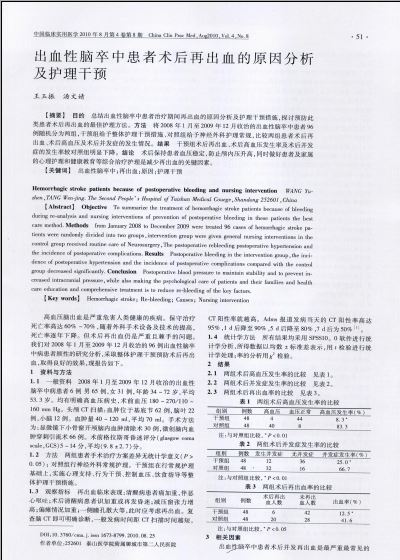出血性脑卒中患者术后再出血的原因分析及护理干预(1)
 |
| 第1页 |
参见附件(1534KB,2页)。
【摘要】 目的 总结出血性脑卒中患者治疗期间再出血的原因分析及护理干预措施,探讨预防此类患者术后再出血的最佳护理方法。方法 将2008年1月至2009年12月收治的出血性脑卒中患者96例随机分为两组,干预组给予整体护理干预措施、对照组给予神经外科护理常规,比较两组患者术后再出血、术后高血压及术后并发症的发生情况。结果 干预组术后再出血、术后高血压发生率及术后并发症的发生率较对照组明显下降。结论 术后保持患者血压稳定,防止颅内压升高,同时做好患者及家属的心理护理和健康教育等综合治疗护理是减少再出血的关键因素。
【关键词】 出血性脑卒中;再出血;原因;护理干预
Hemorrhagic stroke patients because of postoperative bleeding and nursing intervention
WANG Yu-zhen,TANG Wen-jing.
The Second People’s Hospital of Taishan Medical Couege,Shandong 252601,China
【Abstract】 Objective To summarize the treatment of hemorrhagic stroke patients because of bleeding during re-analysis and nursing interventions of prevention of postoperative bleeding in these patients the best care method.Methods from January 2008 to December 2009 were treated 96 cases of hemorrhagic stroke patients were randomly divided into two groups,intervention group were given general nursing interventions in the control group received routine care of Neurosurgery,The postoperative rebleeding postoperative hypertension and the incidence of postoperative complications.Results Postoperative bleeding in the intervention group,the incidence of postoperative hypertension and the incidence of postoperative complications compared with the control group decreased significantly.Conclusion Postoperative blood pressure to maintain stability and to prevent increased intracranial pressure,while also making the psychological care of patients and their families and health care education and comprehensive treatment is to reduce re-bleeding of the key factors.
【Key words】 Hemorrhagic stroke; Re-bleeding; Causes; Nursing intervention
高血压脑出血是严重危害人类健康的疾病。保守治疗死亡率高达60%~70%,随着外科手术设备及技术的提高,死亡率逐年下降。但术后再出血仍是严重且棘手的问题。我们对2008年1月至2009年12月收治的96例出血性脑卒中病患者顾性的研究分析,采取整体护理干预预防术后再出血,取得良好的效果,现报告如下。
1 资料与方法
1.1 一般资料 2008年1月至2009年12月收治的出血性脑卒中病患者6例 男65例,女31例,年龄34~72岁,平均53.3岁。均有明确高血压病史,术前血压180~270/110~160 mm Hg。头颅CT扫描:血肿位于基底节62例,脑叶22例,小脑12例。血肿量40~120 ml,平均70 ml。手术方法为:显微镜下小骨窗开颅脑内血肿清除术30例,微创脑内血肿穿刺引流术66例。术前格拉斯哥昏迷评分(glasgow coma scale,GCS)5~14分,平均(9.8±2.7)分。
1.2 方法 两组患者手术治疗方案差异无统计学意义(P>0.05); 对照组行神经外科常规护理。干预组在行常规护理基础上,实施心理支持、行为干预、控制血压、饮食指导等整体护理干预措施。
1.3 观察指标 再出血临床表现:清醒病患者痛加重,伴恶心呕吐;术后清醒病患者识加重或再发昏迷;减压窗张力增高;偏瘫情况加重;一侧瞳孔散大等,此时应考虑再出血。复查脑CT即可明确诊断,一般发病时间距CT扫描时间越短,CT阳性率就越高。Adms报道发病当天的CT阳性率高达95%,1 d后降至90%,5 d后降至80%,7 d后为50%[1] ......
您现在查看是摘要介绍页,详见PDF附件(1534KB,2页)。